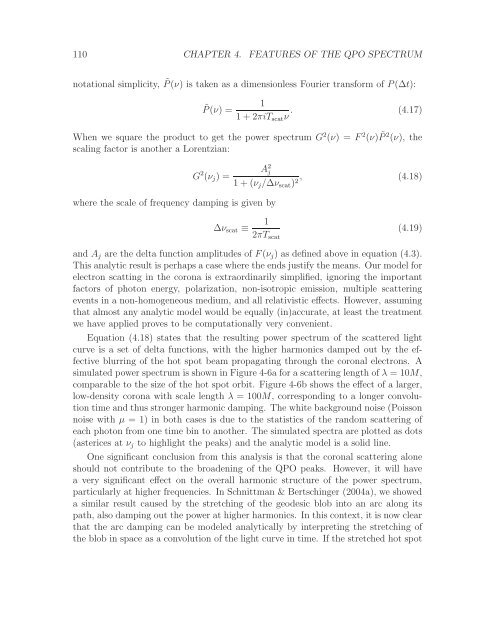Radiation Transport Around Kerr Black Holes Jeremy David ...
Radiation Transport Around Kerr Black Holes Jeremy David ...
Radiation Transport Around Kerr Black Holes Jeremy David ...
You also want an ePaper? Increase the reach of your titles
YUMPU automatically turns print PDFs into web optimized ePapers that Google loves.
110 CHAPTER 4. FEATURES OF THE QPO SPECTRUM<br />
notational simplicity, ˜P(ν) is taken as a dimensionless Fourier transform of P(∆t):<br />
˜P(ν) =<br />
1<br />
1 + 2πiT scat ν . (4.17)<br />
When we square the product to get the power spectrum G 2 (ν) = F 2 (ν) ˜P 2 (ν), the<br />
scaling factor is another a Lorentzian:<br />
G 2 (ν j ) =<br />
where the scale of frequency damping is given by<br />
∆ν scat ≡<br />
A 2 j<br />
1 + (ν j /∆ν scat ) 2,<br />
(4.18)<br />
1<br />
2πT scat<br />
(4.19)<br />
and A j are the delta function amplitudes of F(ν j ) as defined above in equation (4.3).<br />
This analytic result is perhaps a case where the ends justify the means. Our model for<br />
electron scatting in the corona is extraordinarily simplified, ignoring the important<br />
factors of photon energy, polarization, non-isotropic emission, multiple scattering<br />
events in a non-homogeneous medium, and all relativistic effects. However, assuming<br />
that almost any analytic model would be equally (in)accurate, at least the treatment<br />
we have applied proves to be computationally very convenient.<br />
Equation (4.18) states that the resulting power spectrum of the scattered light<br />
curve is a set of delta functions, with the higher harmonics damped out by the effective<br />
blurring of the hot spot beam propagating through the coronal electrons. A<br />
simulated power spectrum is shown in Figure 4-6a for a scattering length of λ = 10M,<br />
comparable to the size of the hot spot orbit. Figure 4-6b shows the effect of a larger,<br />
low-density corona with scale length λ = 100M, corresponding to a longer convolution<br />
time and thus stronger harmonic damping. The white background noise (Poisson<br />
noise with µ = 1) in both cases is due to the statistics of the random scattering of<br />
each photon from one time bin to another. The simulated spectra are plotted as dots<br />
(asterices at ν j to highlight the peaks) and the analytic model is a solid line.<br />
One significant conclusion from this analysis is that the coronal scattering alone<br />
should not contribute to the broadening of the QPO peaks. However, it will have<br />
a very significant effect on the overall harmonic structure of the power spectrum,<br />
particularly at higher frequencies. In Schnittman & Bertschinger (2004a), we showed<br />
a similar result caused by the stretching of the geodesic blob into an arc along its<br />
path, also damping out the power at higher harmonics. In this context, it is now clear<br />
that the arc damping can be modeled analytically by interpreting the stretching of<br />
the blob in space as a convolution of the light curve in time. If the stretched hot spot
















